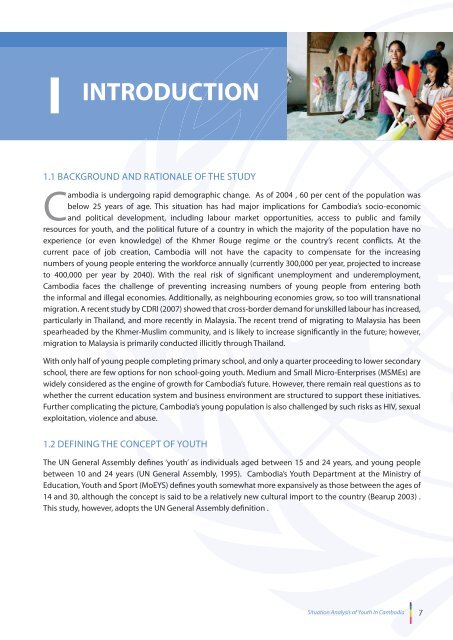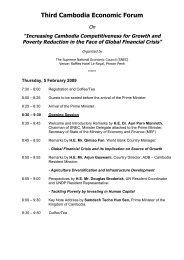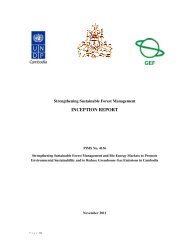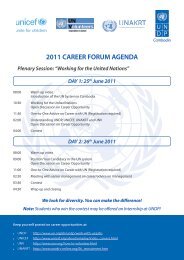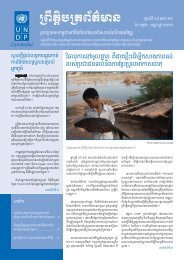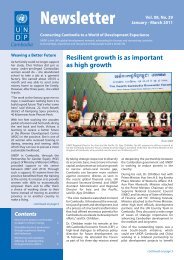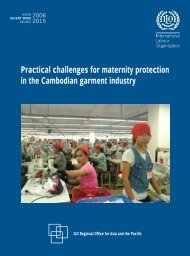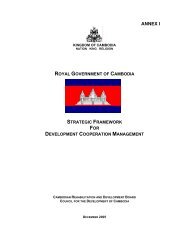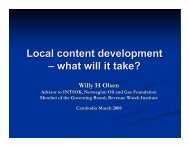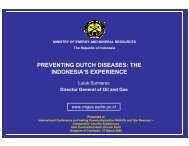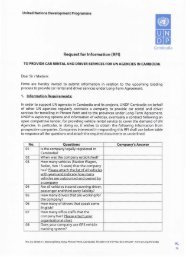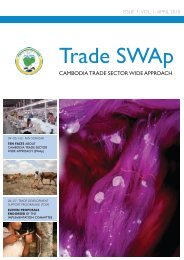UN Analysis Final.pdf - United Nations in Cambodia
UN Analysis Final.pdf - United Nations in Cambodia
UN Analysis Final.pdf - United Nations in Cambodia
Create successful ePaper yourself
Turn your PDF publications into a flip-book with our unique Google optimized e-Paper software.
I<br />
INTRODUCTION<br />
1.1 BACKGRO<strong>UN</strong>D AND RATIONALE OF THE STUDY<br />
<strong>Cambodia</strong> is undergo<strong>in</strong>g rapid demographic change. As of 2004 , 60 per cent of the population was<br />
below 25 years of age. This situation has had major implications for <strong>Cambodia</strong>’s socio-economic<br />
and political development, <strong>in</strong>clud<strong>in</strong>g labour market opportunities, access to public and family<br />
resources for youth, and the political future of a country <strong>in</strong> which the majority of the population have no<br />
experience (or even knowledge) of the Khmer Rouge regime or the country’s recent conflicts. At the<br />
current pace of job creation, <strong>Cambodia</strong> will not have the capacity to compensate for the <strong>in</strong>creas<strong>in</strong>g<br />
numbers of young people enter<strong>in</strong>g the workforce annually (currently 300,000 per year, projected to <strong>in</strong>crease<br />
to 400,000 per year by 2040). With the real risk of significant unemployment and underemployment,<br />
<strong>Cambodia</strong> faces the challenge of prevent<strong>in</strong>g <strong>in</strong>creas<strong>in</strong>g numbers of young people from enter<strong>in</strong>g both<br />
the <strong>in</strong>formal and illegal economies. Additionally, as neighbour<strong>in</strong>g economies grow, so too will transnational<br />
migration. A recent study by CDRI (2007) showed that cross-border demand for unskilled labour has <strong>in</strong>creased,<br />
particularly <strong>in</strong> Thailand, and more recently <strong>in</strong> Malaysia. The recent trend of migrat<strong>in</strong>g to Malaysia has been<br />
spearheaded by the Khmer-Muslim community, and is likely to <strong>in</strong>crease significantly <strong>in</strong> the future; however,<br />
migration to Malaysia is primarily conducted illicitly through Thailand.<br />
With only half of young people complet<strong>in</strong>g primary school, and only a quarter proceed<strong>in</strong>g to lower secondary<br />
school, there are few options for non school-go<strong>in</strong>g youth. Medium and Small Micro-Enterprises (MSMEs) are<br />
widely considered as the eng<strong>in</strong>e of growth for <strong>Cambodia</strong>’s future. However, there rema<strong>in</strong> real questions as to<br />
whether the current education system and bus<strong>in</strong>ess environment are structured to support these <strong>in</strong>itiatives.<br />
Further complicat<strong>in</strong>g the picture, <strong>Cambodia</strong>’s young population is also challenged by such risks as HIV, sexual<br />
exploitation, violence and abuse.<br />
1.2 DEFINING THE CONCEPT OF YOUTH<br />
The <strong>UN</strong> General Assembly def<strong>in</strong>es ‘youth’ as <strong>in</strong>dividuals aged between 15 and 24 years, and young people<br />
between 10 and 24 years (<strong>UN</strong> General Assembly, 1995). <strong>Cambodia</strong>’s Youth Department at the M<strong>in</strong>istry of<br />
Education, Youth and Sport (MoEYS) def<strong>in</strong>es youth somewhat more expansively as those between the ages of<br />
14 and 30, although the concept is said to be a relatively new cultural import to the country (Bearup 2003) .<br />
This study, however, adopts the <strong>UN</strong> General Assembly def<strong>in</strong>ition .<br />
Situation <strong>Analysis</strong> of Youth <strong>in</strong> <strong>Cambodia</strong><br />
7


